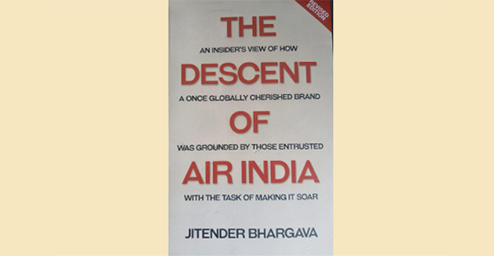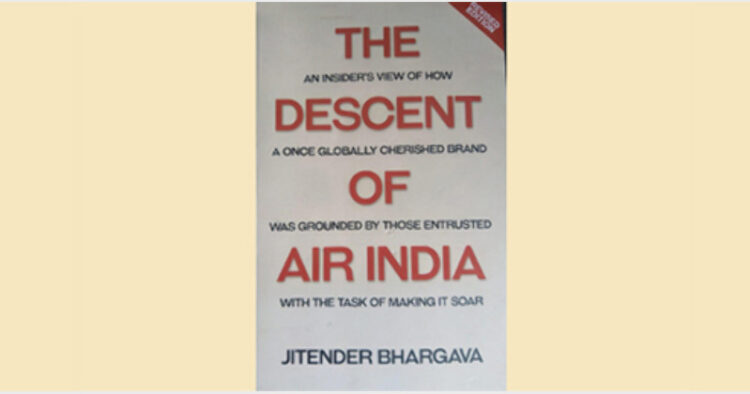This book is a heartbreaking story of how the most respected brand at one time has been reduced to utter penury and sunk into an irretrievable morass

The Descent of Air India, Jitendra Bhargava, Raghubir Sinh, pp 295, Rs. 499 (HD)
In the season of the spirituality of Wuhan-Virus, I was able to finish reading an important document of Indian aviation history, titled “The Descent of Air India” by an insider, Jitender Bhargava. I am aware that many well-intended individuals don’t want Air India to be sold off and believes that it can be revived if political interference is stopped and unions disciplined. He has ideas which he shares with the readers of this book. However, more you read the book, more you realise the futility of the idea of reviving Air India.
What hits you most hard is the way politicians of various hues with their sense of self-importance, vested interests and surety that they would never be caught red-handed have sucked Air India dry; sucking the taxpayers’ blood. Their total disregard for the public money belonging to the citizens of this country is saddening. The boldness in corruption is breath-taking. Controlling a big glamourous business like an airline is such an empowering feeling!
For instance – in 2006, against the estimate of Security department, for 7.5 million INR biometric system, the cost was escalated by the Tender Committee to 4927 million INR by clever tweaking of the norms. The tender was awarded in a few months to a Canadian firm. (Page 140-143) However, the bid was finally abandoned due to sustained objections from the Finance department. This case led to a corruption scandal originating in Canada from where the proposed supplier came, in which a prominent politician too was named. There is a whole chapter ‘A saga of financial mismanagement’ in the book.
The breath-taking profligacy in ordering new aircraft at tax-payers cost against the advice of the experts that finally sunk the airline and our money tells us why we can’t trust politicians to run a complex business like airlines. (Page 154 – 156) One has to read the book to see how many wise men raised their voices but were overruled. Just the long haul aircraft order was increased from 10 to 50, without any serious feasibility study and databased future projections.
The Civil Aviation Ministry that controls Air India and erstwhile Indian Airlines has been run like a private fiefdom by the ministers. Managing Directors and Chairmen of these airlines were changed and removed more easily than a peon is removed. Most of the Managing Directors did not last beyond months, forget years. Only a few honourable exceptions can be pointed out. They too survived, probably, because they did the bidding for their boss, the minister; and strengthened their arguments with a simple explanation, that ‘idea comes from the minister’. The author points out the irony of each Chairman repeating the words of preceding directors, paying homage to great JRD Tata, making the right pitch and finally leaving behind a much weaker Air India. The much-touted board of directors nominated by the government, post-merger, manned by brilliant top minds of the corporate world of India too gave up in despair, and most of them resigned.
The story of moving out of Air India command system from Mumbai to Delhi, is in itself, a sad story of whimsical, irrational working of the leadership. It was because most of the appointees are from the IAS cadre who prefer Lutyen’s Delhi in the company of their friends than the commercial hub of the country. Even if more good money is thrown against the bad money to keep Air India alive, how can we citizens be sure that the politicians will change their ways?
The book reveals the shocking story of blowing the cover off the whistleblower Mr Sunil Arora, who was Chairman cum Managing Director of Indian Airlines when he pointed out irregularities in the working of merged the airline. (Page 157). This story tells us that nobody was interested in honesty or truth. The story doesn’t end there but carries on with the scuttling of a high powered probe into the irregularities and corruption charges.
Bhargava goes into the merger of Air India and Indian Airlines. An idea floated more than a decade back. That no serious thought was given to the serious issue of human resources and imminent clashes, lack of preparation in rationalising and integrating the routes between Air India and Indian Airlines is apparent. Even the orders for new aircraft were not revised with better negotiation power of a huge merged airline. Explanations are aplenty but, none satisfactory. Even while this idea was on the burner, the Ministry undermined Indian Airlines and Air India by gifting away the routes and seats to foreign airlines and private domestic airlines. And, people were wasting their time discussing merger and revival of the national carrier.
The favourite ploy of top managements and politicians is appointing experts committees and costly consultants. But, none of the committee or consultant proposals was accepted or accepted partially. We are aware that reducing the potency of medicine means it will not impact the disease, and may in fact act contrary to the purposes for which it is administered. An international consultancy that was appointed to provide advice was so ignorant of the history of Indian aviation that it claimed in its notes that Indian Airlines was older than Air India! The author repeatedly points out to the unrepentant adamant unions within Air India for its ills and is unhappy that except him, no senior manager or Chairman was tactfully firm. Thus, instead of reigning in of the unions, every leader made them bolder. It is they who hold the key to revival or death of Air India with their behaviour. He has not found the role of the present Civil Aviation ministers very encouraging too.
Jitender Bhargava served for more than 20 years in Air India. He had to suffer various punishments like change in postings. His is an insider’s view. He has collected plenty of documents of his own time and through RTI to nail the culprits, and he has shared these documents in his book. Many readers may not be aware that the first edition of this book had to be called back because of the threat of legal action by an ex-minister of civil aviation. But, since he was sure of his facts, Bhargava refused to be cowed down and republished this revised edition with more ammunition! The ex-minister couldn’t bamboozle him.
As we read the book, we realise that Air India is host to a very difficult triad of unaccountable politicians, tired and voiceless professionals within Air India and the self-serving union leaders. Funds are the least concern as we the citizens’ are the hapless voiceless contributors to this bottomless pit. Do ministers have a vision beyond immediate ego satisfaction of ‘owning’ an airline? Will professional managers be empowered and given confidence that they will be given free rein to run their departments efficiently? Will intransigent unions become responsible and realise that their selfish interests are best served if Air India thrives? Will political leadership see through this maze and bring clarity to this mission of having a national carrier, whether public or private, that we can be proud of?
We are still talking of utopia of a revived Air India. But, is it possible to reach there, if we refuse to learn from the experience? To get a precise understanding of these questions, The Descent of Air India is a must-read for all the stakeholders.
(The reviewer is an author and columnist)














Comments